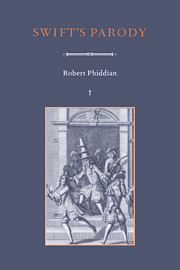Book contents
- Frontmatter
- Contents
- Acknowledgments
- List of abbreviations
- Introduction
- 1 Theoretical orientations
- 2 Restoration enterprises and their rhetorics
- 3 Parody and the play of stigma in pamphlet warfare
- 4 The problem of anarchic parody: An Argument against Abolishing Christianity
- 5 Authority and the author: the disappearing centre in Swiftian parody
- 6 Entrance to A Tale of A Tub
- 7 A Tale of A Tub as an orphaned text
- 8 A Tale of A Tub as Swift's own illegitimate issue
- Conclusion: parodic disguise and the negotiability of A Tale of A Tub
- Select bibliography
- Index
8 - A Tale of A Tub as Swift's own illegitimate issue
Published online by Cambridge University Press: 29 September 2009
- Frontmatter
- Contents
- Acknowledgments
- List of abbreviations
- Introduction
- 1 Theoretical orientations
- 2 Restoration enterprises and their rhetorics
- 3 Parody and the play of stigma in pamphlet warfare
- 4 The problem of anarchic parody: An Argument against Abolishing Christianity
- 5 Authority and the author: the disappearing centre in Swiftian parody
- 6 Entrance to A Tale of A Tub
- 7 A Tale of A Tub as an orphaned text
- 8 A Tale of A Tub as Swift's own illegitimate issue
- Conclusion: parodic disguise and the negotiability of A Tale of A Tub
- Select bibliography
- Index
Summary
He thinks it no fair Proceeding, that any Person should offer determinately to fix a name upon the Author of this Discourse, who hath all along concealed himself from most of his nearest Friends: Yet several have gone a farther Step, and pronounced another Book to have been the Work of the same Hand with this; which the Author directly affirms to be a thorough mistake; he having yet never so much as read that Discourse, a plain Instance how little Truth, there often is in general Surmises, or in Conjectures drawn from a Similitude of Style, or way of thinking.
(p. 6)Fair proceeding or not, Swift concealed himself so carefully that A Tale was fathered on several possible authors at the time of publication, and the task of determinately fixing a name to it cannot even now be said to be complete. He was always elusive about the publication of his writings, but his attitude to A Tale was uncommonly evasive and prickly. An anxious desire for anonymity, at odds with a sometimes adolescent pride in virtuosity, remains a deep and problematic principle throughout the book. Although the author, using the proprietorial metaphors of conception and origin, aggressively proclaims that ‘He conceived it was never disputed to be an Original, whatever Faults it might have’ (p. 13), he shows no eagerness to disclose the identity of this original artist.
- Type
- Chapter
- Information
- Swift's Parody , pp. 172 - 196Publisher: Cambridge University PressPrint publication year: 1995

